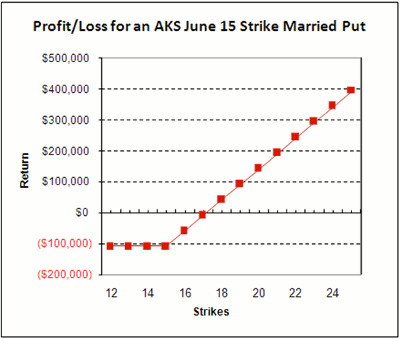AK Steel Holding Corp. (AKS) attracted a wave of call volume last week despite a bearish brokerage note from Goldman Sachs. Specifically, the firm downgraded AKS to "sell" from "neutral," stating that a weak electrical steel market and increasing pressure from imports would weigh on the company's earnings. Following the downgrade, AKS plunged more than 7% to trade just above former long-term resistance at the $15 level.
On the options front, nearly 10,000 calls changed hands on Friday alone, more than tripling the stock's average daily call volume, and flying in the face of Goldman's downgrade. The most active strike was the February 15 call, where more than 3,600 contracts crossed the tape by mid-morning. However, while skimming AKS options volume for unusual activity, a put trade caught my eye, as it appears that a bullish investor is utilizing these typically bearish options to hedge a long AKS stock position.
This type of play is typically called a married put, and it’s a good example of how one option trader placed the trade.
The Anatomy of an AK Steel Married Put
Specifically, at about 11:49 am on Friday, the trader purchased 500 AKS June 15 puts for the ask price of $1.68, or $168 per contract, on the Philadelphia Stock Exchangemarried put position, the total outlay for the put options was $84,000—[($1.68 x 100) x 500]—while the total cost of the stock position was $773,000.
Now, for those of you not familiar with married puts, this strategy involves buying a stock (a long position) and buying a put (a short position), and may seem counterintuitive. However, the actual strategy behind the trade is pretty simple.
Basically, by purchasing a put option for every 100 shares of the underlying stock, you are guaranteeing a minimum selling price for the shares should they retreat before the option contract expires. As you can see, this is a reassuring and very handy option strategy in the current market environment.
Potential Outcomes
There are several potential outcomes for this married put position. For example, let's say that AKS turns sharply south and is trading at $10 per share when June options expire. By exercising the June 15 put, the trader can sell his shares for $15 apiece, or $750,000 total. While the trader loses roughly $107,000—[($750,000 - $773,000) - $84,000]—he would have lost $273,000—($773,000 - $500,000)—had he not set a stop-loss by purchasing the put options as a hedge.
On the other hand, let's assume that AKS rallies by the time June options expire, finishing at $20 per share. In this case, the June 15 puts expire worthless, meaning that the trader forfeits the $84,000 premium paid for the married puts. However, since the AKS stock position gained roughly $227,000 since the married put position was opened, the trader is still sitting on a profit of about $143,000— ($1,000,000 - $773,000) - $84,000.
Furthermore, the trader also has the option of retaining his AKS shares and repeating the process with another married put, or selling them for $20 each and exiting the position completely.
For those investors looking to try out this strategy, it is important to remember that by entering a married put position, you are not looking to make a profit from the purchased put option. Because you are long, or bullish, on the underlying stock, your primary objective is for the shares to rally. As such, the put purchased is only a stop-loss to protect against any unforeseen bumps in the road.
And, while you'll have to forfeit the initial premium paid should the underlying stock journey higher, the cost of the "coverage" is a small price to pay to sleep a little better at night.
By Joseph Hargett, contributor, Schaeffer’s Trading Floor Blog






















